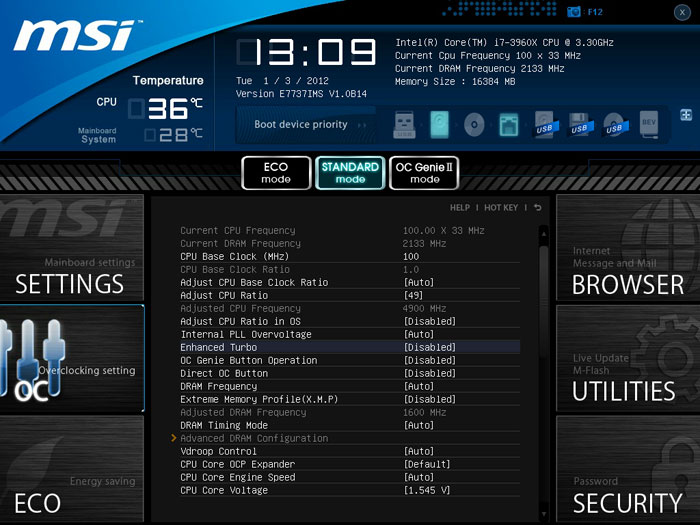Overclocking - EFI BIOS screenshots
Reaching new heights - Overclocking
With so much ridiculous horsepower in the system, (an engineering sample we must add) we could not resist trying out overclocking. We're keeping it simple, but anything over Gulftown on LCS (roughly 4.2 GHz) is a win in our book for this six-headed beast.
Pretty much we need to take a couple of steps if we want to overclock. Invest in good hardware by the way, the cheaper motherboards often are not well tuned for enthusiast overclocking.
Today we'll test this motherboard in two stages benchmarks wise, normal baseline mode and last but not least we'll overclock manually towards 4.9 GHz.
Manual overclocking
The true guru3d audience overclocks from the BIOS and tries to find the maximum stable limit. The generic overclock procedure for multiplier based overclocking is as follows (this can differ a little per motherboard but the idea is the same):
- Leave baseclock for what it is right now
- If optional in the BIOS, increase your TDP limits of the processor to 245 Watts (by that you are allowing a higher power draw)
- Leave your base multiplier at default e.g. 34
- Set the per core Turbo multiplier at a maximum of your liking, we applied an MP of 49 on all six cores
- Increase CPU voltage, though setting AUTO might work fine, we applied 1.55V on the processor cores
- Make sure your processor is properly cooled (we used the Corsair H100 LCS cooler at performance settings)
- Save and Exit BIOS / EFI
In the MSI BIOS there's also a value called CPU-SA voltage, bring that to ~1.45 Volts for a little extra stability and also lock in your memory at 1.6V for that little extra overclocking booty.
So these settings allow us to work at a baseline clock of roughly 3400 MHZ that can actually still throttle down to 1200MHz in idle, which helps us in power consumption. However, once the processor gets a kick in the proverbial nuts, it can turbo any or all cores towards that multiplier of 49 times that 100 MHz baseclock frequency, that's a 4900 MHz configuration.
A Prime95 stress test with all four cores active and stressed at 4900 MHz. You'll need a rather good cooler as temperatures are on the borderline of acceptable. In fact let me rephrase that, we already went way too far.
Mind you that there are many ways to overclock, you could also disable the turbo and just go for the reference frequency. With the help of a new buffer you can also overclock on the bus a little better in 33 MHz increments top, say 133 and 166 MHz. The sky is the limit. Fool around we say... the motherboard is made for this.
Anyway we'll include baseline (default), and manual overclock (4.9 GHz) results in the benchmarks today.

I know I know... but this engineering sample CPU requires a lot of voltage and the H100 can't coop with it at these frequencies, hence our ~4.9 GHz limit. The temperature is limiting us to OC any higher.
EFI BIOS (MSI CLICK BIOS)
MSI embeds the new EFI BIOS is an Extensible Firmware Interface that complies with EFI architecture, offering a user-friendly interface that goes beyond traditional keyboard-only BIOS controls to enable a way more flexible and convenient mouse input at BIOS level.EFI (Unified Extensible Firmware Interface) is a specification detailing an interface that helps hand off control of the system for the pre-boot environment (i.e.: after the system is powered on, but before the operating system starts) to an operating system, such as Windows.EFI is an interface. It can be implemented on top of a traditional BIOS (in which case it supplants the traditional "INT" entry points into BIOS) or on top of non-BIOS implementations.

End-users can navigate the new EFI BIOS (basic input/output system) with the same smoothness as their operating system. It's simply a Windows OS feel. The EFI mode displays frequently-accessed setup info, experienced performance enthusiasts that demand far more intricate system settings and you can go nuts in there.
Compared to a regular BIOS the EFI BIOS is more handy to use and easy to navigate. It makes common functions really fail proof, features like flashing a BIOS is done in a jiffy and all variables can be managed and monitored really easy. We'll see a lot of ODMs make a move to the EFI BIOS this year.
